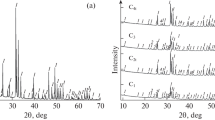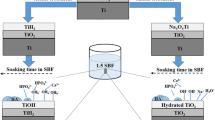Abstract
Titania coatings with various morphologies were formed on titanium surfaces by hydrothermal treatment using a dilute alkaline solution and evaluated in their hydroxyapatite (HA)-forming abilities in simulated body fluid (1.5SBF) under ultraviolet (UV) irradiation. The HA formation on the titania coating in 1.5SBF was enhanced by UV irradiation. The amount of phosphate groups adsorbed on the titania, after soaking in 1.5SBF for 24 h under UV irradiation, was estimated to be larger than that of calcium ions, whereas that of calcium ions on the titania, after soaking without UV irradiation, was larger than that of phosphate groups. It was suggested that the titania generated much basic Ti–OH groups at its surface by UV irradiation and subsequently adsorbed phosphate groups, such as H2PO4−, resulting in the formation of a new surface rich in the amount of the groups, which eventually enhanced the HA formation in 1.5SBF.







Similar content being viewed by others
References
W.R. Lacefield: An Introduction to Bioceramics World Scientific Singapore 1993 223–238
T. Kokubo: Apatite formation on surfaces of ceramics, metals and polymers in body environment. Acta Mater. 46, 2519 1998
H-M. Kim, F. Miyaji, T. Kokubo, T. Nakamura: Apatite-forming ability of alkali-treated Ti metal in body environment. J. Ceram. Soc. Jpn. 105, 111 1997
T. Kokubo, F. Miyaji, H-M. Kim, T. Nakamura: Spontaneous formation of bonelike apatite layer on chemically treated titanium metals. J. Am. Ceram. Soc. 79, 1127 1996
C. Ohtsuki, H. Iida, S. Hayakawa, A. Osaka: Bioactivity of titanium treated with hydrogen peroxide solutions containing metal chlorides. J. Biomed. Mater. Res. 35, 39 1997
X-X. Wang, S. Hayakawa, K. Tsuru, A. Osaka: A comparative study of in vitro apatite deposition on heat-, H2O2, and NaOH-treated titanium surfaces. J. Biomed. Mater. Res. 54, 172 2001
H-M. Kim, H. Takadama, F. Miyaji, T. Kokubo, S. Nishiguchi, T. Nakamura: Formation of bioactive functionally graded structure on Ti–6Al–4V alloy by chemical surface treatment. J. Mater. Sci.-Mater. Med. 11, 555 2000
T. Peltola, M. Patsi, H. Rahiala, I. Kangasniemi, A. Yli-Urpo: Calcium phosphate induction by sol-gel-derived titania coatings on titanium substrates in vitro. J. Biomed. Mater. Res. 41, 504 1998
P. Li, I. Kangasniemi, K. de Groot, T. Kokubo: Bonelike hydroxyapatite induction by a gel-derived titania on a titanium substrate. J. Am. Ceram. Soc. 77, 1307 1994
K. Yanagisawa, J. Ovenstone: Crystallization of anatase from amorphous titania using the hydrothermal technique: Effects of starting material and temperature. J. Phys. Chem. B 103, 7781 1999
J. Yang, S. Mei, J.M.F. Ferreira: Hydrothermal synthesis of nanosized titania powders: Influence of peptization and peptizing agents on the crystalline phases and phase transitions. J. Am. Ceram. Soc. 83, 1361 2000
R. Wang, K. Hashimoto, A. Fujishima, M. Chikuni, E. Kojima, A. Kitamura, M. Shimohigoshi, T. Watanabe: Light-induced amphiphilic surfaces. Nature 388, 431 1997
T. Kasuga, H. Kondo, M. Nogami: Apatite formation on TiO2 in simulated body fluid. J. Cryst. Growth 235, 235 2002
K. Kakiuchi, E. Hosono, H. Imai, T. Kimura, S. Fujihara: {111}-faceting of low-temperature processed rutile TiO2 rods. J. Cryst. Growth 293, 541 2006
H. Takadama, H-M. Kim, T. Kokubo, T. Nakamura: TEM-EDX study of mechanism of bonelike apatite formation on bioactive titanium metal in simulated body fluid. J. Biomed. Mater. Res. 57, 441 2001
M. Tanahashi, T. Matsuda: Surface functional group dependence on apatite formation on self-assembled monolayers in a simulated body fluid. J. Biomed. Mater. Res. 34, 305 1997
Acknowledgment
This research was supported by Research Fellowships of the Japan Society for the Promotion of Science for Young Scientists.
Author information
Authors and Affiliations
Corresponding author
Rights and permissions
About this article
Cite this article
Obata, A., Zhai, T. & Kasuga, T. Apatite-forming ability on titanium surface modified by hydrothermal treatment and ultraviolet irradiation. Journal of Materials Research 23, 3169–3175 (2008). https://doi.org/10.1557/JMR.2008.0385
Received:
Accepted:
Published:
Issue Date:
DOI: https://doi.org/10.1557/JMR.2008.0385




